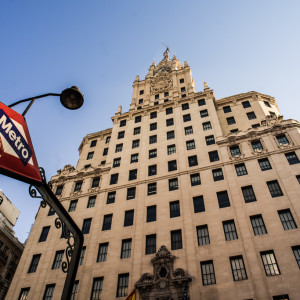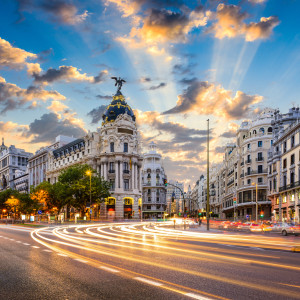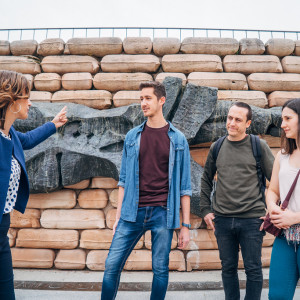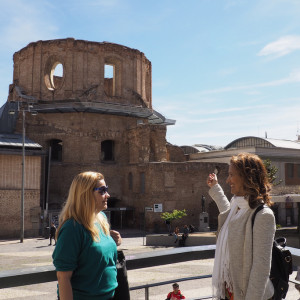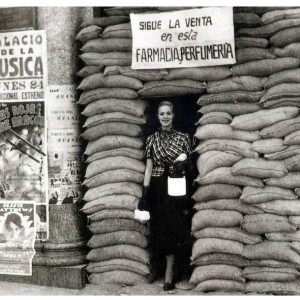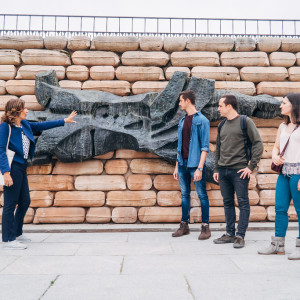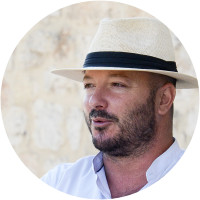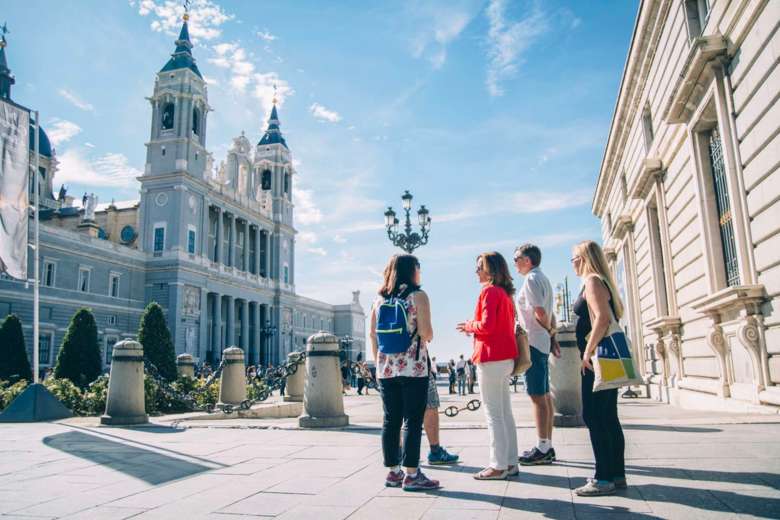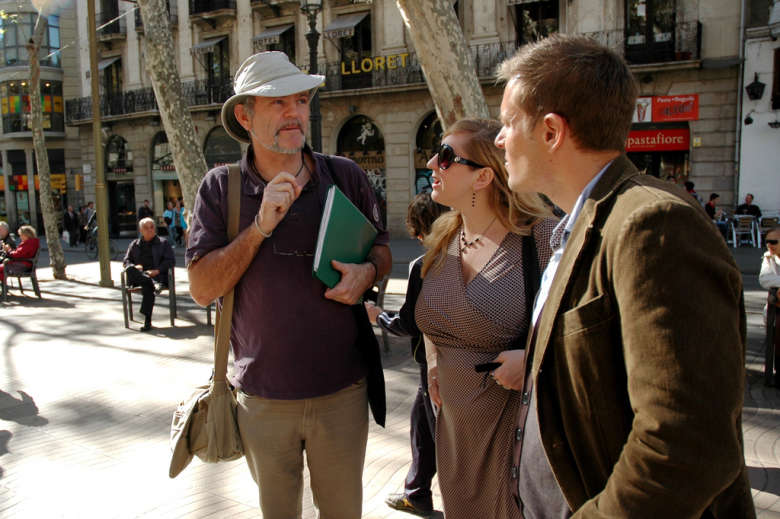Tour Details
- Duration
- 3.5 hours
- Product Type
- Tour
- Venues
-
- Reina Sofia Museum
- Lavapiés
- Monument to the Fallen
- Telefónica Building
- Gran Vía
Select a date
Tour Description
On a hot summer’s day in 1936, a military coup trying to overthrow the government escalated into one of the most important historical events leading to the rise of fascism in Europe: The Spanish Civil War. This acute three-year conflict divided the Spanish population and territory in two—the Republicans, supported by international volunteer forces, versus the Nationalists, backed by the Fascist regimes of Mussolini and Hitler. Our 3.5-hour Spanish Civil War tour in Madrid will focus on the origins of the war, visiting sites associated with wartime events and covering daily life during the war and Nationalist Francisco Franco’s eventual Fascist dictatorship.
We begin our tour at a cafe where we’ll introduce the Spanish Civil War's major players. Armed with this knowledge, we’ll embark on our journey through the Civil War in Madrid, starting with Franco’s Monument to the Fallen, constructed during his regime on the site of the city’s first skirmish. We’ll continue along Gran Vía, a commercial and entertainment artery where the Telefónica Building—one of Europe’s first skyscrapers—became the main target for bombardments.
Passing through Puerta del Sol, we’ll enter the working-class neighborhood of Lavapiés. Intensely bombed during the war, we will see the ruins of a Catholic school and church burnt by angry masses at the onset of the conflict; these stand as a vivid illustration of the savagery of the war. Using photos and testimonies from the period, our guide will illustrate the difficulty of daily life during the first half of a dictatorship known in Spain as Los Años de Hambre, or The Years of Hunger.
The Spanish Civil War was one of the most romanticized conflicts of the 20th century, inspiring the works of an accomplished list of contemporary writers and artists, including Ernest Hemingway, George Orwell, Orson Welles, Dorothy Parker, Pablo Neruda, and Pablo Picasso. Picasso’s Guernica is one the most recognizable symbols of the horrors of war, but it served as a key piece of propaganda used to gather support for the war. In light of its influential status, we’ll end our walk at the nearby Reina Sofía Museum, where we’ll view this monumental oeuvre together to wrap up our discussion of the war’s tremendous effect on this country.
This tour will help impart the scale of devastation that accompanied the rise of Franco and Fascism in Spain, as well as demonstrate the Spanish Civil War's impact on arts and culture.
Experts
- You're a history buff looking to expand your knowledge of the Civil War and follow the lead of an expert in his field.
- It's your first time in Madrid and you're eager to learn about the history of this incredible city.
- You’re an experienced traveler and want to dive deep into the importance of this iconic historical event that shaped this nation.
- Reina Sofia Museum
- Lavapiés
- Monument to the Fallen
- Telefónica Building
-
Gran Vía
Tickets
- You are prepaid for the tour and the entry tickets at the Reina Sofia Museum.
Resources
- If you are eager to learn more about Madrid before your visit, check out our online lectures at Context Learning.
Wheelchair accessibility
We understand that some of our valued guests may have mobility concerns, and we want to ensure you have a comfortable and enjoyable experience throughout your tour. If there are any accessibility concerns that your tour guide will need to be aware of, please let our team know at the time of booking.
How much time is spent at the Reina Sofia museum? We typically spend half an hour or so in the museum to see Guernica - for a longer more in depth look at the collection we recommend our Reina Sofia tour.
Book with confidence — see Context's flexible cancellation policy here.
Where You'll Start
–
102 Reviews
Reviews can only be left by Context customers after they have completed a tour. For more information about our reviews, please see our FAQ.
Really enjoyed our Spanish Civil War tour yesterday with Jesús. I loved that it began with some solid background and contextual information, to put the tour and our activities into perspective. I really learned a lot and appreciate the nuanced and balanced information Jesús presented. The tour really brought the complex history to life. Jesús was really knowledgeable on all aspects of the war, as well as Madrid, and he provided us with an excellent background and lots of context before we started walking. I was really impressed with his well rounded knowledge of related topics, and it was just fun to talk to him. The tour was great but Jesús made it even better with his personality and stories. Loved the tour!
Jennifer
May. 21, 2024
Sean navigated us through so many spots of Madrid to help illustrate the Civil War which we weren’t that familiar with. The cafe where we started was quite the bonus-we had lunch there before we met Sean-delicious.
Anna
May. 5, 2024
Our two-person tour led by Context Travel’s guide, Carlos, was the highlight of our visit to Madrid. The story of the Spanish Civil War is complex and Carlos’ knowledge of events before, during and after was both broad and deep. And we even walked away with some excellent restaurant recommendations! But let’s back up.
Spain, or more broadly, the Iberian Peninsula, has history. For visitors who want to move beyond tapas bars and historic cathedrals to get under the skin of this region’s history to the present, learning about the Spanish Civil War connects many dots that include the combatants in WWII, a war that ironically, Spain sat out (more or less).
In our case, we preceded our visit reading, skimming actually, everything from Wikipedia entries to a couple library books. Nevertheless, the Civil War was an enigma. Then we joined guide Carlos on a street corner to begin our tour.
Over the next ~4 hours we began with a march toward Parque du Oeste. Dog walkers and people idling in the park on a nice spring afternoon belied the trauma and violence that occurred in this region. Carlos brought us to bunkers, remnants from bloody conflicts. Then on to the Ark of Victoria, a Francoist celebratory monument. And then to the evocative Monumento A Los Caidos Del Cuartel De La Montana adjacent to the reconstructed Temple of DeBod, a gift from Egypt. But, wait, this was not merely a tour of monuments. All along the way, Carlos, whose English was excellent having spent 3 years in the US, sustained a continuous patter of what was happening in these fateful days beginning in July 1936. A story he supported with a portfolio of historic then and now pictures.
At one point, Carlos turned us to face a lively city intersection crowded with the ubiquitous street cafes and small shops. Then he displayed from his portfolio of photographs this precise location in 1936/37 with bombed out shops, holes in the streets and human casualties. It was a story effectively told by Carlos.
A quick hop on the Metro and we arrived at Reina Sofia Museum dedicated to Spanish Art, but also a repository for poster and news imagery published during the Civil War. And, of course, the cornerstone of the museum’s collection is Picasso’s Guernica which, following several hours of Spanish Civil War immersion, represented itself not only as great art but as a powerful reflection on a complex and very uncivil civil war.
In sum, the tour was thoughtful, well-constructed and effectively concluded with the dramatic imagery of Picasso’s Guernica. And Carlos’ enthusiastic narration and amiable responsiveness to our constant interruptions and interrogations accentuated the value of this trek around Madrid. It was time and money well-spent.
Rena
Apr. 11, 2024
